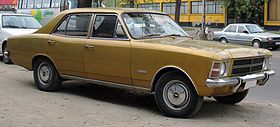
The Chevrolet Impala is a full-size car that was built by Chevrolet for model years 1958 to 1985, 1994 to 1996, and 2000 to 2020. The Impala was Chevrolet's popular flagship passenger car and was among the better-selling American-made automobiles in the United States.
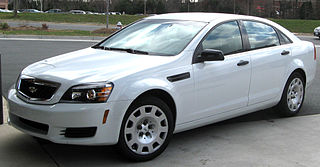
The Chevrolet Caprice is a full-size car produced by Chevrolet in North America for the 1965 through 1996 model years. Full-size Chevrolet sales peaked in 1965, with over a million units sold. It was the most popular car in the U.S. in the 1960s and early 1970s, which, during its production, included the Biscayne, Bel Air, and Impala.

The Chevrolet Bel Air is a full-size car produced by Chevrolet for the 1950–1981 model years. Initially, only the two-door hardtops in the Chevrolet model range were designated with the Bel Air name from 1950 to 1952. With the 1953 model year, the Bel Air name was changed from a designation for a unique body shape to a premium level of trim applied across a number of body styles. The Bel Air continued with various other trim level designations, and it had gone from a mid-level trim car to a budget fleet sedan when U.S. production ceased in 1975. Production continued in Canada, for its home market only, through the 1981 model year.

The Opel Omega is an executive car engineered and manufactured by German automaker Opel between 1986 and 2004. The first generation, the Omega A (1986–1994), superseded the Opel Rekord. It was voted European Car of the Year for 1987, and was available as a saloon or estate. The second generation, the Omega B, was manufactured from 1994 to 2004.

The Tempest is an automobile that was produced by Pontiac from 1960 to 1970, and again from 1987 to 1991.
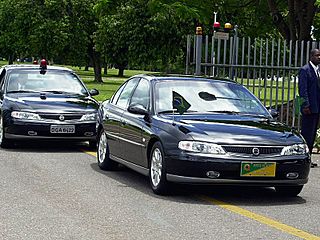
The Chevrolet Omega is an executive car sold by Chevrolet for the Brazilian market. Replacing the Chevrolet Opala, which was a development of the Opel Rekord C, the original Chevrolet Omega was based on the Opel Omega A and built locally between 1992 and 1998. After 1999, local production ceased, and General Motors do Brasil imported badge engineered versions of the Holden Commodore from Australia.
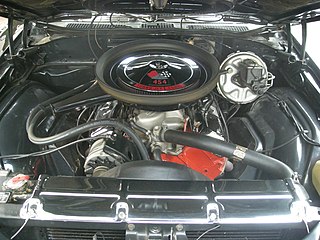
The Chevrolet "big-block" engine is a term for a series of large-displacement, naturally-aspirated, 90°, overhead valve, gasoline-powered, V8 engines; that were developed and produced by the Chevrolet Division of General Motors, from the 1950s until present.

The Chevrolet small-block engine is a series of gasoline-powered V8 automobile engines, produced by the Chevrolet division of General Motors between 1954 and 2003, using the same basic engine block. Referred to as a "small-block" for its size relative to the physically much larger Chevrolet big-block engines, the small-block family spanned from 262 cu in (4.3 L) to 400 cu in (6.6 L) in displacement. Engineer Ed Cole is credited with leading the design for this engine. The engine block and cylinder heads were cast at Saginaw Metal Casting Operations in Saginaw, Michigan.
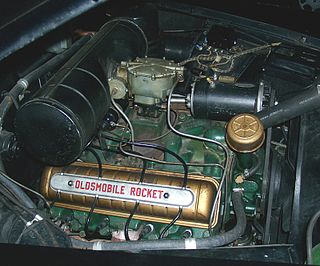
The Oldsmobile V8, also referred to as the Rocket, is a series of engines that was produced by Oldsmobile from 1949 until 1990. The Rocket, along with the 1949 Cadillac V8, were the first post-war OHV crossflow cylinder head V8 engines produced by General Motors. Like all other GM divisions, Olds continued building its own V8 engine family for decades, adopting the corporate Chevrolet 350 small-block and Cadillac Northstar engine only in the 1990s. All Oldsmobile V8s were assembled at plants in Lansing, Michigan while the engine block and cylinder heads were cast at Saginaw Metal Casting Operations.

The Opel Rekord is a large family car which was built in eight generations by the German car manufacturer Opel. Between 1953 and 1986, approximately ten million were sold.

The Chevrolet Monte Carlo is a two-door coupe that was manufactured and marketed by the Chevrolet division of General Motors. Deriving its name from the city in Monaco, the Monte Carlo was marketed as the first personal luxury car of the Chevrolet brand. Introduced for the 1970 model year, the model line was produced across six generations through the 2007 model year, with a hiatus from 1989 until 1994. The Monte Carlo was a variant of the Pontiac Grand Prix throughout its production.
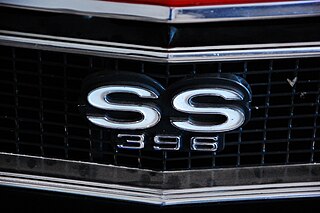
Super Sport, or SS, is the signature performance option package offered by the Chevrolet division of General Motors on a limited number of its vehicles. All SS models come with distinctive "SS" markings on their exterior. The SS package was first made available for the 1961 Impala. Some of the other models bearing the SS badge include the Camaro, Chevelle, El Camino, Impala, Monte Carlo, Nova and Chevrolet Pickup Trucks. Current SS models are produced by the GM Performance Division.

The Opel Commodore is an executive car (E-segment) produced by Opel from 1967 to 1982. It is the six-cylinder variant of the Rekord with styling differences. The Commodore nameplate was used by Opel from 1967 to 1982. However, its nameplate/lineage continued until 2020 with the Australian Holden Commodore. The last generation was sold in the United Kingdom primarily as the Vauxhall Viceroy although Opel models were also sold.

The Opel Diplomat is a luxury car manufactured by Opel from 1964 to 1977. Opel's top-ranging models were traditionally the Admiral and Kapitän, introduced in 1938 and 1937 respectively.
Ranger was an automobile brand of General Motors which was produced from 1968 to 1978. Used in three main markets, the original automobile was marketed as "South Africa's Own Car" and was built in Port Elizabeth, South Africa, from 1968 to 1973. The European model range was sold in two main markets, Belgium and Switzerland. It was produced by General Motors Continental SA from 1970 to 1978 in Antwerp, Belgium. General Motors Suisse SA in Biel-Bienne, Switzerland, also produced Rangers from 1970 until that factory's closure in 1975. A few Rangers were also sold in the Netherlands.

The Family II is a straight-4 piston engine that was originally developed by Opel in the 1970s, debuting in 1981. Available in a wide range of cubic capacities ranging from 1598 to 2405 cc, it simultaneously replaced the Opel CIH and Vauxhall Slant-4 engines, and was GM Europe's core mid-sized powerplant design for much of the 1980s, and provided the basis for the later Ecotec series of engines in the 1990s.

The Chevrolet 90° V6 family of V6 engines began in 1978 with the Chevrolet 200 cu in (3.3 L) as the base engine for the all new 1978 Chevrolet Malibu. The original engine family was phased out in early 2014, with its final use as the 4.3 L (262 cu in) V6 engine used in Chevrolet and GMC trucks and vans. Its phaseout marks the end of an era of Chevrolet small-block engine designs dating back to the 1955 model year. A new Generation V 4.3 L (262 cu in) V6 variant entered production in late 2013, based on the LT1 small block V8 and first used in the 2014 Silverado/Sierra 1500 trucks.
The Chevrolet 153 cu in engine was an inline-four engine designed in the early 1960s for use in the Chevy II. It is a four-cylinder variant of the Turbo-Thrift six-cylinder engine. After 1970, GM ceased production of the 153 engine in North America because of low demand, but the engine continued to be used in cars in other markets around the world, notably in South Africa and South America. The engine was also standard equipment in the Jeep DJ-5A—used by the United States Postal Service—until American Motors bought Kaiser Jeep in 1970 and replaced the engine with the AMC straight-six in the DJ-5B. Currently descendants of the 153 engine are used in industrial and marine applications. The 153 engine is entirely different from the 151 cu in (2.5 L) Iron Duke engine introduced by Pontiac in 1977, most noticeably never having featured the Pontiac engine's crossflow cylinder head, but the two are often confused today.

The Opel Rekord Series C is a large family car that was introduced in August 1966, by Opel as a replacement for the short-lived Opel Rekord Series B. It was slightly larger all round than its predecessor, from which it inherited most of its engines. It continued in production until replaced by the Opel Rekord Series D at the end of 1971.

The Chevrolet Turbo-Thrift engine is a straight-six produced from 1962 to 2001 by the Chevrolet division of General Motors. The entire series of engines was commonly called Turbo-Thrift, although the name was first used on the 230 cubic inch version that debuted in 1963. The new engine featured seven main bearings in lieu of the four bearing design of its predecessor, the "Stovebolt" engine, and was considerably smaller and approximately 100 lbs lighter.
